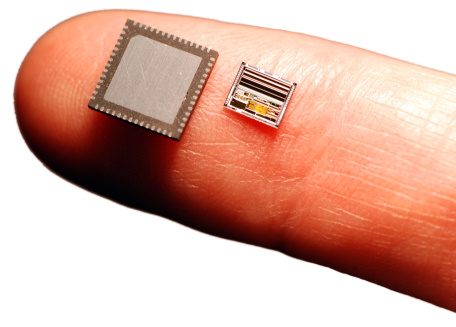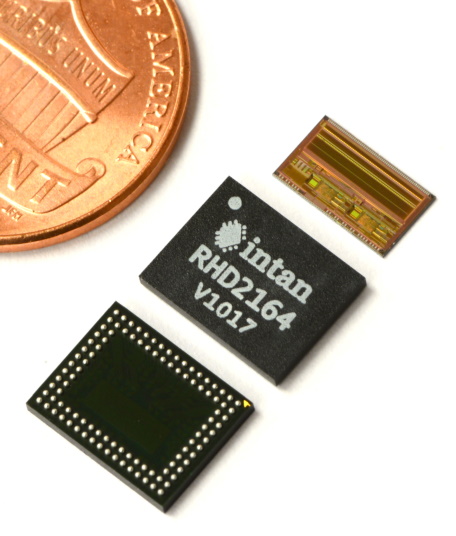RHD Electrophysiology Amplifier Chips
RHD2000 electrophysiology amplifier chips detect and acquire weak electrical signals from living tissue. Each integrated circuit contains banks of low-noise amplifiers with programmable bandwidths and are suitable for a wide variety of biopotential monitoring applications. Here are actual biological signals acquired using RHD2000 chips.
Innovative circuit architecture combines amplifiers, filters, a 16-bit ADC, and impedance measurement onto a single silicon chip. Up to 64 recording electrodes are connected directly to the chip and digital data streams out on a standard SPI bus.
Programmable registers configure the upper and lower bandwidths of the amplifiers. This flexibility allows the chips to be optimized for many different types of electrophysiological signals including ECG, EMG, ECoG, neural spikes, and local field potentials.
By transforming weak electrode signals directly into a digital data stream, an RHD2000 chip replaces all analog instrumentation and digitizing circuitry in electrophysiology recording systems. Intan Technologies provides an open-source API to stream digital data from multiple RHD2000 chips to a host computer in real time.
Our RHD recording system offers a variety of headstages using RHD2216, RHD2132, and RHD2164 chips. This system offers a quick way to evaluate the performance of these chips with a plug-and-play USB interface and open-source, multi-platform GUI software.
RHD2000 Family
- RHD2216 16-channel amplifier chip with bipolar (differential) inputs
- RHD2132 32-channel amplifier chip with unipolar inputs and common reference
- RHD2164 64-channel amplifier chip with unipolar inputs and common reference
Features
- Fully integrated electrophysiology amplifiers with 16-bit ADC and industry-standard serial peripheral interface (SPI)
- ADC samples amplifiers up to 30 kSamples/s per channel
- Low noise floor: 2.4 μV rms typical
- Upper cutoff frequency configurable from 100 Hz to 20 kHz
- Lower cutoff frequency configurable from 0.1 Hz to 500 Hz
- Integrated multi-frequency in situ electrode impedance measurement capability
- Auxiliary ADC inputs for interfacing additional off-chip sensors
Applications
- Miniaturized multi-channel headstages for neural recording
- Massively parallel neural recording for advanced brain activity mapping
- Low-power wireless headstages or backpacks for electrophysiology experiments
- "Smart Petri dish" in vitro recording systems
- Simultaneous recording of action potentials and local field potentials (LFPs) from microelectrodes

|
|---|
| RHD2132 32-channel amplifier chips in QFN package and in bare die form. |
|---|

|
|---|
| RHD2164 64-channel amplifier chips in BGA package and in bare die form. |
|---|
Supporting Documents
- RHD2000 series electrophysiology amplifier chip datasheet
- RHD2164 64-channel chip datasheet
- Bond pad diagrams for RHD2216/RHD2132 bare die
- Bond pad diagrams for RHD2164 bare die
- Device moisture sensitivity guide
- Intan RHD2000 parts library in Eagle PCB format
- RHD2000 Rhythm USB2 API
- RHD2000 Rhythm USB3 API
- FAQ: Why is the gain of the RHD amplifiers fixed?
- FAQ: RHD amplifier filter characteristics

